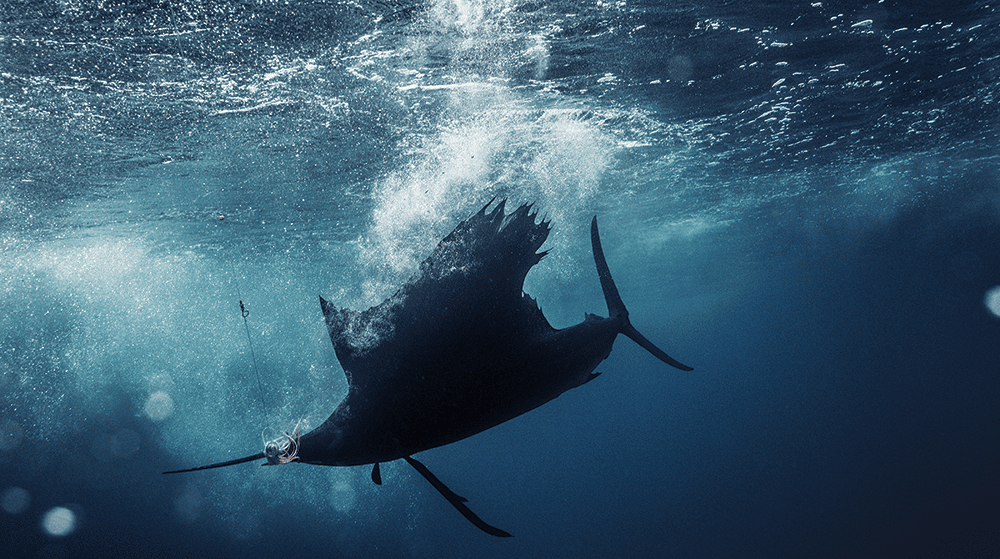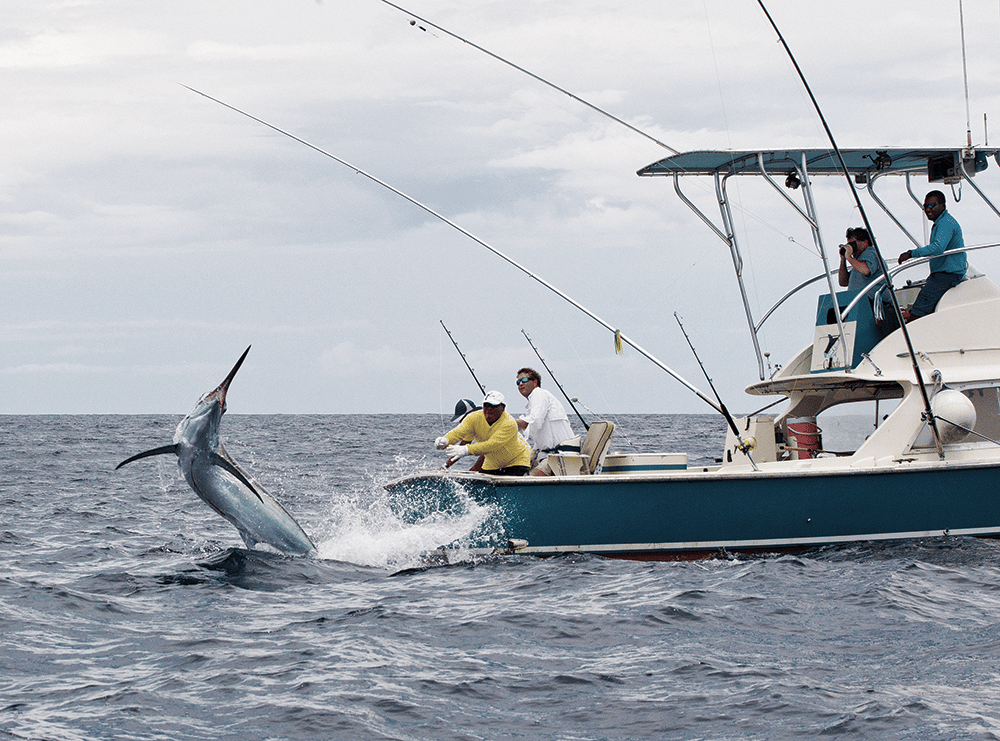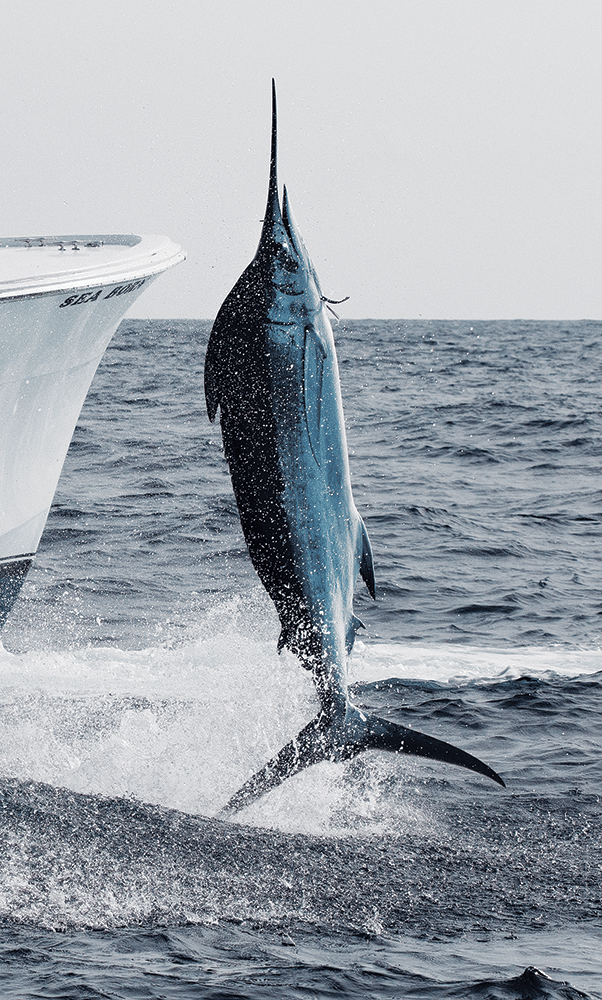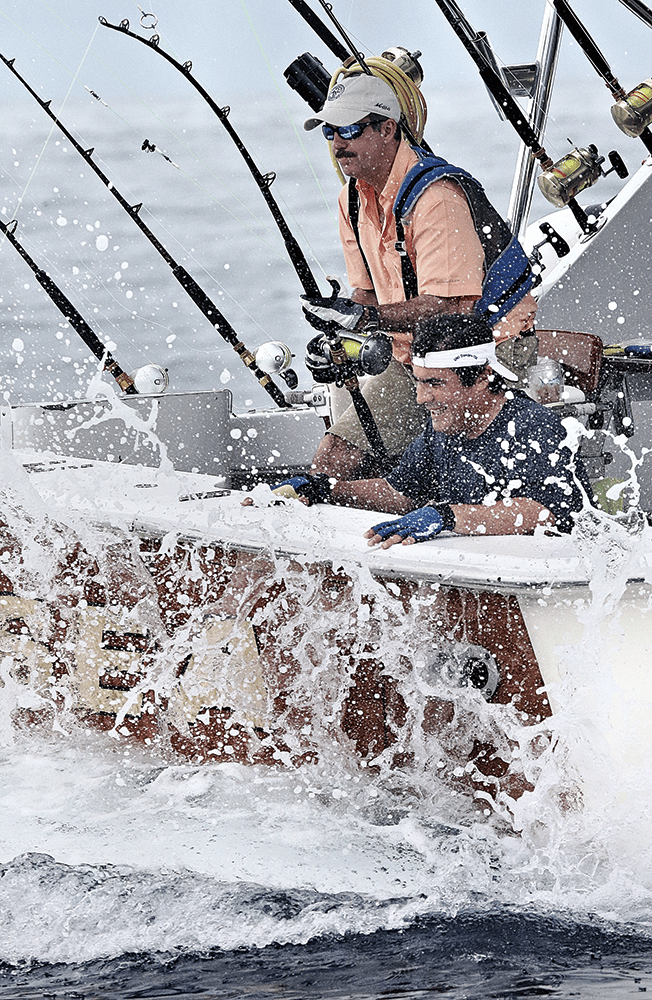
Ascent to Glory
A heart-throbbing scene unfolds on the deck of a sport-fisher as a marlin pops up in the trolling spread, dorsal flung high and pectorals aglow. With powerful, staccato sweeps of its massive tail, the billfish bursts toward the right flat line. All hell breaks loose as the billfish attacks. The crew scurries to action. A rod bends double. A clicker screams. Line melts away in a high‑speed blur.
It is what offshore anglers live for.
Yet when it comes to big-game fish, this scenario seems to repeat more for some boats than others. Such “lucky” sport-fishers seem to possess mythical powers, raising innumerable fish from the depths as if by tractor beam.
But do boats really attract offshore species such as mahi, marlin, sailfish, tuna and wahoo? Are some boats more apt to raise offshore fish than others? And if so, what is it that causes fish to home in on such an unnatural object as a boat?
These are the questions to which I sought answers from a variety of offshore-angling experts who have fished around the world, from Hawaii to Cape Hatteras to Guatemala.
Passing FAD
More than one expert has likened a boat to a floating object on the offshore grounds, where game fish are attracted to things such as weed lines and kelp paddies, as well as discarded pallets, offshore weather buoys and man-made FADs (fish-aggregating devices). In their shade and sanctuary, these floating objects often harbor a community of marine life spanning the food chain. So why wouldn’t fish view a boat — despite its transient nature — in the same way?
Anecdotal evidence suggests that a boat in and of itself — whether moving or stationary — will attract fish, according to most of the experts I talked with. What’s more, most believe that visual cues associated with the boat have a stronger influence on fish than do sounds or vibrations.
Supporting these assertions are observations by Hawaiian fishing authority and writer, Jim Rizzuto, who tells of two large yellowfin tuna swimming in the shadow of a 30-foot sport-fisher as it trolled for marlin. “The ahi were snuggling up against the hull and seemed not at all upset at the sight and sound of the boat,” Rizzuto says.
Anecdotal evidence suggests that a boat in and of itself — whether moving or stationary — will attract fish.
In addition, a big blue marlin showed about the same time. He estimated the fish in the 1,000-pound range. “All of these big fish seemed to be attracted to the boat and didn’t want to swim away” Rizzuto said. They appeared to make the boat their home, at least until the crew caught the yellowfin, though they failed to get the marlin.
During a recent trip down the Pacific Coast of Baja California, I witnessed a similar phenomenon in which a huge school of mahi vacated their residence under the floating carcass of a dead seal, preferring the shade of our drifting 39-foot SeaVee. The school stayed with us as we caught and released fish for more than two hours until we decided to throttle up and head for port.
Big Teaser
In some ways, a moving boat might be even more attractive to predatory fish than a stationary object. This is due to what some might call the big-teaser effect. Like a large, hookless teaser lure designed to create a commotion on the surface to simulate a school of fish attacking bait and draw the attention of a curious predator, the prop wash, froth, and splashing of the boat hull may accomplish the same thing.
Most big-game anglers assume that a boat moving through the water is your biggest teaser and the first thing that notifies a billfish of your presence. A boat is larger than any teaser, attracting fish from a distance. They see the boat, the teaser, then your bait.
Some captains believe that the boldest fish are also the largest ones, at least when it comes marlin, and so they are more likely to get close to the boat. “In Hawaii, the lures closest to the boat often draw strikes from the biggest fish,” Rizzuto says. Yet, the longer trolling lines usually take smaller fish.
A boat is larger than any teaser, attracting fish from a distance. They see the boat, the teaser, then your bait.
“As a result, big-game trollers generally position their largest lures just a few wakes back,” the Hawaiian angling expert explains.
The type of wake a boat lays down can also affect success, according to Randy Ramsey, president of North Carolina-based Jarrett Bay Boatworks. “Billfish are sight feeders, and a clean wake allows them to see the baits or lures more easily,” Ramsey explains.
Three factors that help keep create clean wakes include a hull that’s free of fouling, properly aligned running gear and well-tuned propellers, Ramsey believes.

Animal Magnetism
Pied Piper
Most experts agree that sound also plays a role in how well a boat raises offshore fish. While no one has conducted empirical testing, boats emitting the thrum from a pair of big diesel engines certainly catch a fair share of offshore fish. Yet, could this be the result of the greater number of twin-diesel sport‑fishers out there trolling?
Plenty of fish have also been caught by anglers trolling with multiple four-stroke outboard engines. That number seems to be on the rise as more and more supersize center-console boats head out to pursue big-game fish.
Many assert that the key seems to be the resonance set up between two or more marine power plants, rather than the type of engine. This results in a pulsed low-frequency sound underwater that draws in fish from a distance.
It has been long established that sharks are attracted to low-frequency, pulsed white noise, much like the sound of injured baitfish or a pair of out-of-synch diesel engines. We can only assume that billfish are attracted to this noise as well.
The correct harmonics make a big difference in whether fish will come to the boat to look at the lures, according to Capt. Brad Philipps, who runs Guatemala Fishing Adventures and has released more than 25,000 billfish.
“A captain’s preference for a -particular trolling speed may reflect his boat’s ‘sweet spot,’” he says. “Engines turning at a certain rpm range may produce a set of harmonics that raise billfish like the Pied Piper.”
How does he know when he has achieved this? The fish tell him so. “I know I’m pulling at the right speed when we’re getting as many or more bites than the boats around us.”
The type of hull construction might also play a role, Ramsey contends. “I look at boats such as Big Oh, Chainlink, Inspiration and Sensation — boats that have been successful with different crews,” he says. “One thing they all have in common is that these are wooden-cored boats. While these hulls might not be popular, wooden-cored boats might make them better at raising fish.”

Stay Tuned
Sometimes the harmonics can turn sour. This was the case with Kona, Hawaii, Capt. John Bagwell, according to Rizzuto. Bagwell and his boat, Silky, had been on a hot streak. He and his crew had won the 2013 Skins Tournament with a 645-pound blue marlin, and followed it up a few weeks later with Henry Chee Award for the highest-scoring skipper in the Hawaiian International Billfish Tournament (Aug. 3-10, 2013).
“Later in the year, however, Bagwell began to wonder if his 45-foot Viking had lost its competitive edge,” says Rizzuto. “The captain began to think the engines didn’t sound right.”
The fish evidently felt the same, as the boat was not getting as many blue marlin strikes as earlier in the year. So Bagwell had the boat hauled and ordered tune-ups on the twin 485 Detroit diesels, transmissions and running gear.
After the tune-up, Silky was again running as smoothly as its name, according to Rizzuto. And the fish returned to its wake. Silky and its crew picked up the pace, releasing a steady stream of billfish, just as before.
The lesson here: Sport-fishers require regular tune-ups if they are to maintain the harmonics that attract fish. “A squeaky bearing or bent prop blade could blow up into expensive problems,” says Rizzuto, “but none bigger than dragging down the fish count.”
Echoing that sentiment is Jarrett Bay’s Ramsey. “One thing is for sure,” he says, “if a boat has a bad vibration, bearing noise, bent prop shaft or other issues, this hurts the boat’s ability to raise fish.”
Ramsey points to evidence based on the success of new boats. “Have you ever noticed that new boats seem to catch better than older ones?” he asks. “I think it is because the bearings and running gear are tight. Crews and owners should pay attention to this as their boats age, and ensure everything is running properly.”
Size Can Matter
It seems that bigger sport-fishing boats consistently rack up higher scores than do smaller boats. But again, this might simply be a matter of numbers: In most parts of the world, there are more large sport-fishers offshore at any given time than there are smaller boats. And because of their size, larger boats can go big-game fishing on days when marginal weather and large seas force smaller boats to stay in port.
Yet, according to many experts, fish don’t care what kind of boat you are on. In my experience, I have found success in raising striped marlin off Southern California behind even smaller boats, including a -single-diesel-powered 26-foot convertible and a single-outboard-powered 22-foot center-console. Yet in most cases, the marlin were as thick as fleas offshore. On tougher days, the larger boats with twin engines seemed to hold the advantage when it came to trolling.
Running large hookless teasers, daisy chains of artificial squid, or dredges can help create more -commotion and enlarge your offshore “footprint” while trolling in a boat that’s smaller than rest of the fleet, and this can help level the playing field when fishing among the big boys.

Large and In Charge
Sounder Proof
How can you tell if your boat’s fishy? There is a way to test its fish-attracting power, according to Rizzuto, but it relies on keeping your eye on the fish finder. Sport-fishers equipped with high-quality fish finders — especially the newer CHIRP high-definition sounders — can mark fish such as marlin and tuna as deep as 20 to 30 fathoms.
“When you spot a marlin or tuna down deep on the fish finder, turn your head around and look at your wake,” Rizzuto advises. “Then count to 20.” It takes about 10 to 20 seconds for a curious blue marlin to swim to the surface to investigate, he contends.
“A squeaky bearing or bent prop blade could blow up into expensive problems, but none bigger than dragging down the fish count.”
Jim Rizzuto
“If you don’t see the fish slashing at your lures or tracking them, mark the spot on your GPS chart plotter and circle back after you are sure your lures have cleared the area with no interest from a billfish,” he adds. “Troll over the area again, and give the fish another chance to investigate.”
Raising fish such a marlin or tuna in this manner will prove that your boat has fish-attracting power, Rizzuto claims. “Every week I hear stories from skippers who have marked fish down deep and brought them up successfully for a solid strike,” he adds.
Men and Machine
Of course, a boat alone will not catch fish. The experience, knowledge, and hard work of an energetic captain and crew rank as essential elements of offshore success. It is the crew’s intimate understanding of how to take advantage of a boat’s fish-attracting characteristics that proves critical. The crew’s ability to select the best lures, gauge the proper trolling distances and choose the right speed — not only for the boat, but for the ever-changing sea conditions — can often mean more than anything else.
Just as a fine guitar requires a talented musician to make music, a modern fishing machine requires the skill of its captain and crew to make fish rise to the trolling spread. And when it comes together, there’s nothing in this world that’s more exciting. That’s why I call it raising havoc.








